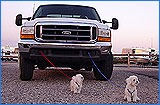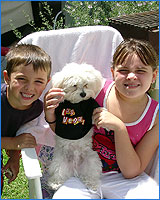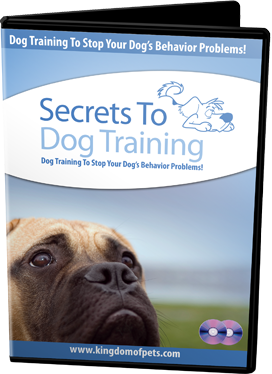If you are looking for the greatest gold-mine of easy to use "change your dog's behavior" advice ever crammed into a newsletter series then read on!
Also, make sure that you check out our 100% authentic testimonials from people who have bought Secrets to Dog Training and find out the massive difference it has made to their owner-dog relationship!
 "Hi Daniel, Wanted you to know how very happy we are with our purchase of Secrets to Dog Training. With the price of fuel continuing to rise, it is more important now than ever before for a well trained pulling team for our family sled. Your book allowed us to do what others thought impossible (see picture)! We now have a very fuel efficient, two-dogpower engine for our truck!
"Hi Daniel, Wanted you to know how very happy we are with our purchase of Secrets to Dog Training. With the price of fuel continuing to rise, it is more important now than ever before for a well trained pulling team for our family sled. Your book allowed us to do what others thought impossible (see picture)! We now have a very fuel efficient, two-dogpower engine for our truck!
All kidding aside, We have been most happy with the results of your books. As my wife continues to spoil our two little treasures, I continue to use the techniques illustrated in your book keep them under control and make well mannered little citizens out of them. First, of course, came the house training task. I found your book invaluable for this most important task. 100% success but not without effort! Being watchful and persistent, as illustrated in the House Training Methods and Tricks section of Secrets to Dog Training, was really the key but the tips and tricks you shared made the task quicker, easier and more tolerable. Then came the basic commands which we found, as you suggested, are critical! I used your book as a bible here and, little by little, our babies are responding to all our commands. We're still not confident to walk them without a leash but I do believe that there will come a day that we will be comfortable with that. Persistence and patience once again! But the biggest task and accomplishment of all was in the establishment of the pecking order of our pack (family). I have become the "Alpha Dog" and I must admit that educating my wife to this concept was a much bigger challenge than educating King Midas and Sir Micro.
She thought that this was the meanest, cruelest thing I have done to the boys since my use of the infamous crate during housebreaking. My salvation was in finally convincing her (forcing her actually) to read the sections of your book pertaining to these concepts. Once she got through that, she became so enthralled that she couldn't put the book down until she finished it. Now we are a team in our training efforts and the results are amazing. Of course, I have maintained my position as Alpha Dog but she is now Second in Command.
 Thank you so much for your book. All our efforts previous to it were in vain with very little success. Our little guys are still babies (10 months old and 15 months old) and we realize that training is an ongoing and long term process, but we already have two little guys that we are very proud of. Just like well behaved children, they are a joy to be around and a pleasure to show off to friends and strangers alike. Although we both have read your book and supplements from cover to cover, we now use them as an excellent reference as new problems and challenges appear. Keep up the great work."
Thank you so much for your book. All our efforts previous to it were in vain with very little success. Our little guys are still babies (10 months old and 15 months old) and we realize that training is an ongoing and long term process, but we already have two little guys that we are very proud of. Just like well behaved children, they are a joy to be around and a pleasure to show off to friends and strangers alike. Although we both have read your book and supplements from cover to cover, we now use them as an excellent reference as new problems and challenges appear. Keep up the great work."
-- Lee & Bev Daly and the M&M's (Midas & Micro)
By Daniel Stevens
Humans play solitaire to keep themselves occupied when they’re alone. Dogs chew. It’s what they do. Actually, chewing is much more important to dogs than solitaire is to humans. Dogs need to chew on things to maintain healthy teeth and gums and good jaw strength. Solitaire will do nothing for your dental hygiene.
Puppies need to chew even more when they are teething (in fact, there are special chew toys that can be dampened and frozen to provide relief for painful gums during this process). So chewing isn’t a problem in itself, but destructive chewing is. Dogs need to learn what they can and cannot chew on, and they are quite capable of doing so when properly taught. Here are four steps every dog owner should take to encourage "constructive chewing."
1. Prevent. As always the best cure, but dog owners should always dog proof their home, especially with puppies. They can be very creative with what they chew. Anything not removable that has been or is likely to be targeted can be sprayed with a deterrent, such as Bitter Apple.
2. Interrupt. Whenever you are there with your dog, it is important that you actively teach them commands for "leave it" or "drop." These are given whenever you see them taking something into their jaws that should not be in there. You may have to orchestrate this training process by adding some of the items that you removed in step 1. But that’s what training is all about - setting up safe scenarios in which you can help them differentiate between appropriate and inappropriate behavior. These commands will also work well when you are out with your dog and they want to pick up something dangerous or just foul.
3. Redirect. Here’s where you start teaching your friend which toys belong to them, to chew to pieces if they like (and they will). Immediately after removing the inappropriate item from their clutches, replace it with an appropriate toy. It will take some time to really zero in on a few of your dog’s most favorite things. But as you try lots of different toys to encourage constructive chewing, keep in mind that the best ones are those designed to promote healthy teeth and gums such as dental chew ropes. Also, try to find what are called "active toys," which give your dog something to do for an extended period of time. For example, "Kong" balls and rubber toys can be stuffed with food, such as peanut butter or whatever they go for. Often dogs are inactive when they are alone because they’re missing you.
4. Praise. The final step is simple but not one to forget.
The good news is that most dogs will grow out of this phase somewhat at the same time as they figure out what’s chewable and what’s not. If your dog’s chewing problem continues, however, it is likely to be an expression of nervous energy (the same goes for excessive licking, of themselves and others). The number one cause of nervous energy for dogs is lack of exercise.
A brisk 15-minute walk is simply not enough for many dogs, barely a warm-up for a Border Collie, and it is important to understand that exercise is different from a play session or outing to the park.
The mistake that a lot of dog owners make, which is an unfortunate function of their busy schedules, is that they pack in two high intensity (15-20 minute) fetch sessions at the beginning and end of the day. True, this is much better than nothing, but the fact that the dog goes more or less from sleeping to sprinting, then from lying around all day to sprinting again, can cause extra wear and tear on the joints and possibly early arthritis. Like humans, a dog benefits from a decent warm-up and warm-down, and busy owners should do their best to sneak in some longer, less intense exercise sessions.
All the best with it, and don’t chew out your dog in the meantime.
Daniel Stevens and the Secrets to Dog Training Team
"Secrets to Dog Training - STOP Dog Behavior Problems!"
 I've been a professional dog trainer for well over 20 years, and in that time I've helped thousands of dog owners just like you to get the friendly, well behaved, slipper fetching, best pal they always wanted.
I've been a professional dog trainer for well over 20 years, and in that time I've helped thousands of dog owners just like you to get the friendly, well behaved, slipper fetching, best pal they always wanted.
But it didn't start out that way. I've always loved dogs, some things never change. But when I first started my professional dog training career I relied on the so-called 'best practices' when it came to dog behavior training. It was only when I heard people tell me over and over again that they just weren't seeing results that I started to question the old accepted wisdom. So I started a journey, a quest to search out the best, most effective, techniques, tips, and tricks that really work.
And that's how I came up with Secrets to Dog Training. Year after year I found new techniques that achieved the results I wanted. Eventually I had a whole book worth of great resources: Secrets to Dog training...
So, if you want to:
Then Secrets to Dog Training is just what you've been looking for!
Previous newsletters
| 01 | 02 | 03 | 04 | 05 | 06 | 07 | 08 | 09 | 10 | 11 | 12 | 13 | 14 | 15 | 16 | 17 | 18 | 19 | 20 | 21 | 22 | 23 | 24 | 25 |
| 26 | 27 | 28 | 29 | 30 | 31 | 32 | 33 |34 | 35 | 36 | 37 | 38 | 39 | 40 | 41 | 42 | 43 | 44 | 45 | 46 | 47 | 48 | 49 | 50 |
| 51 | 52 | 53 |54 | 55 | 56 | 57 | 58 | 59 | 60 | 61 | 62 | 63 | 64 | 65 | 66 | 67 | 68 | 69 | 70 | 71 | 72 | 73 | 74 | 75 |
| 76 | 77 | 78 | 79 | 80 | 81 | 82 | 83 | 84 | 85 | 86 | 87 | 88 | 89 | 90 | 91 | 92 | 93 | 94 | 95 | 96 |